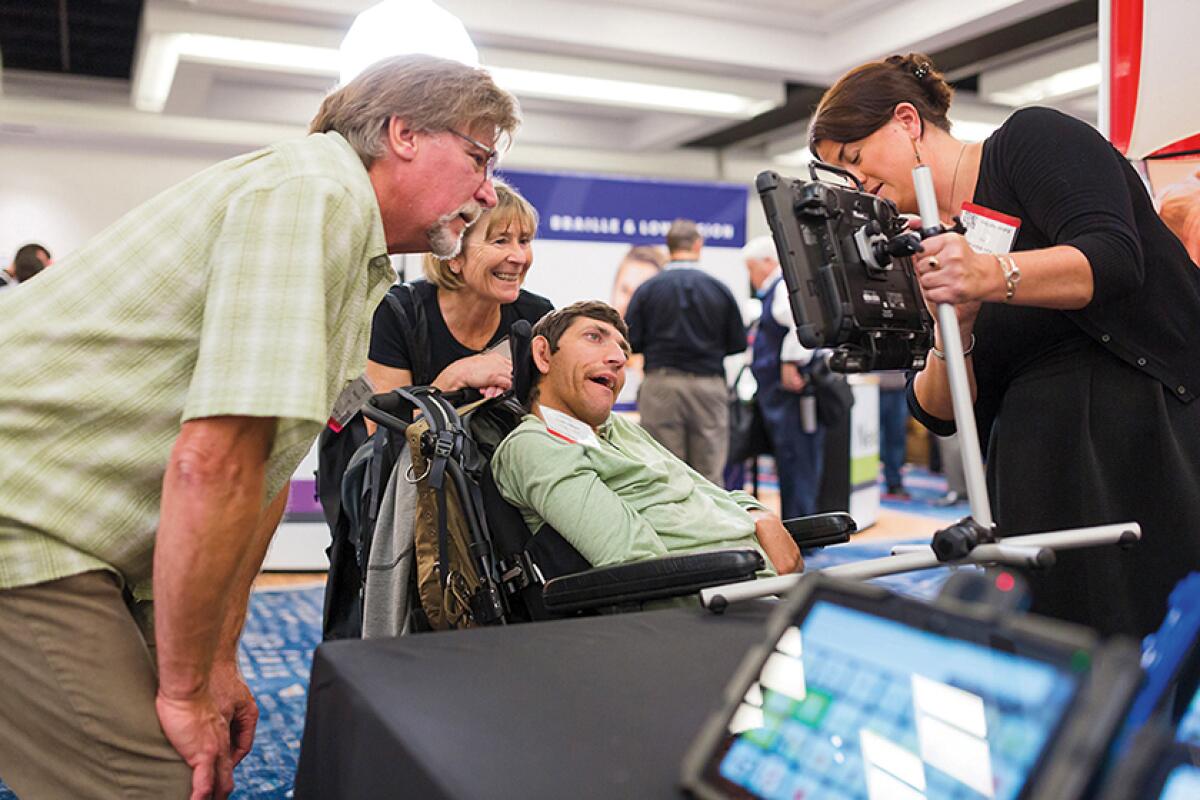CSUN Assistive Technology Conference Showcases Innovations for a More Inclusive World

- Share via
The exhibit hall at the CSUN Assistive Technology Conference featured a treasure trove of devices and software that help people with disabilities navigate - and fully experience - the world.
There were apps that audibly describe the surrounding world for people with impaired vision, phones that display scrolling captions of conversations for people with hearing loss and spoons with stabilizing handles for individuals with hand tremors.
At a recent conference, one wearable video camera, BrainPort V100, connected to an oral electrode array that stimulated shapes and patterns on the user’s tongue, essentially painting pictures for the visually impaired wearer to imagine.
“We had a grandfather who said he saw his grandchild for the first time,” said William A. Conn, then-vice president of sales and marketing for BrainPort Technologies, the company displaying the device.
Assistive technology can be as complex as the BrainPort camera or as commonplace as reading glasses. According to the World Health Organization, more than 1 billion people globally need one or more assistive devices, and the demand is expected to double by 2030.
The CSUN Assistive Technology Conference offers experts in the field of assistive technology, users of the technology, and advocates to come together to exchange ideas and solutions that move us toward a society of greater inclusivity and belonging.
Technology for All
Conceived in the mid-1980s, the CSUN Assistive Technology Conference (then known as the International Conference on Technology and Persons with Disabilities) was the brainchild of Dr. Harry Murphy, then-director of CSUN’s Center on Disabilities, and a disabilities specialist with decades of experience working with the Deaf and Hard of Hearing communities.
In the decades since, the event has earned an international reputation as the premier conference of its kind.
Whether it’s an app or a modified wheelchair, touring the exhibit hall showcases the most up-to-date assistive technology, prototypes or time-tested solutions.
A wristband recently on display used sonar to locate obstacles near people with visual impairments, then vibrated to help navigate around them. An app connected people who are blind or have low vision to trained agents who serve as “on-demand eyes.”
Even if all conference attendees aren’t in the business of developing assistive technology, they are certainly interested in using it. Corporate participants include Amazon, T-Mobile and Sony, for example. While these companies aren’t necessarily developers of assistive technology, they recognize their customer base consists of those with disabilities and the importance of offering the best experience to all customers.
“The mission set in the 1980s is just as important today. All across the conference, there are thought leaders, industry professionals and end users committed to the same goal of making the world an inclusive and accessible place for all people,” said Julia Santiago, interim managing director of the Center on Disabilities, the center that organizes the conference.
A recurring theme at the conferences is the need for tech companies to change their cultures to focus on accessibility. Further work in this area remains to be done as past keynote speakers have called upon businesses to reframe the understanding of disability and beneficiaries of assistive technology, and to work harder toward inclusivity.
Johanna Lucht, the first NASA engineer who is deaf and has taken an active role in the control room during a crewed test flight, delivered a keynote address at the 34th conference that stressed removing barriers to developing assistive technology. She noted that many of the most beneficial technologies for people with disabilities were not designed for that purpose. For example, ridesharing services such as Uber removed potential miscommunications that occurred when the Deaf or Hard of Hearing ordered taxis through interpreter services - the apps have enabled people to type in exact addresses.
Conversely, video closed captioning can benefit people without disabilities enabling individuals to better understand content in a noisy space. “The point I’m making is, society is too hung up on the definition behind assistive technology,” Lucht said.
“This technology can also benefit everyone.”
Microsoft is one company that has been praised for its inclusive hiring practices, including programs to hire people with intellectual developmental disabilities and individuals with autism. In 2018, Microsoft Chief Accessibility Officer Jenny Lay-Flurrie discussed these programs, noting candidates with autism are often extremely qualified but by traditional measures do not perform well in interviews. Individuals who approach tasks differently are valuable in creative problem-solving.
Lay-Flurrie, who is deaf, also discussed the company’s commitment to accessibility features in products and customer support, such as a free app that narrates the world, and a more prominent display of the Accessibility Checker tool that notifies users of accessibility issues in their content - a feature beneficial to everyone.
Commitment to Inclusivity
Today, the conference attracts nearly 5,000 participants from all 50 states and more than 35 countries. It has an international reputation for expanding the knowledge base of professionals and introducing newcomers to the field. It is part of a long history of involvement in assisting people with disabilities dating back to 1961, when the university was known as San Fernando Valley State College.
“As an institution that is fiercely committed to advancing and advocating for equity, access and inclusion, CSUN is proud to host this annual conference. Our efforts encompass all facets of inclusivity, and we recognize that we need to continue to accelerate our work if we are to realize a society where everyone can participate, contribute and thrive. This objective has always been at the heart of CSUN and this conference,” said CSUN President Erika D. Beck.
The 38th Assistive Technology Conference takes place on March 13-17, 2023 at the Anaheim Marriott. The exhibit hall is open to the public and admission is free from March 15-17, 2023.